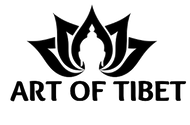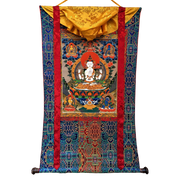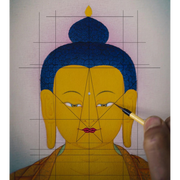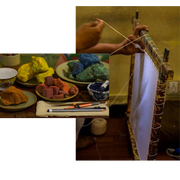Yama Dharmaraja Thangka
SPRING SALE
Get it between - .

Yama Dharmaraja Thangka – The King of the Law
This Tibetan Thangka depicting Yama Dharmaraja is a powerful and striking addition to any home décor. Hand-drawn in the Kathmandu Valley, Nepal, this 100% hand-painted Thangka is perfect for transforming your space, whether as a centerpiece wall hanging in your home or office, or placed on your family altar to attract benevolent energy and support spiritual growth. It is a stunning representation of Tibetan Buddhist art, bringing emotional healing, meditative focus, and a sense of divine protection into your life.
Specification
- Dimensions: 43 x 30 cm
- Materials: 24 Carat Gold and Tibetan Colors mixed with Hide Glue
- Canvas: Organic Cotton
- Master Quality Thangka
- Hand Painted in Nepal
About Yama Dharmaraja
Yama Dharmaraja, the King of the Law, is a fierce and important figure in both Tibetan Buddhism and Indian mythology. Originally known as the Lord of Death in ancient Indian mythology, Yama's role as the judge of souls at the gates of hell made him a figure of fear. However, within Buddhism, his nature has been transformed by Manjushri, who has brought him under control as a Dharma protector (Dharmapala). As a protector deity, Yama Dharmaraja plays a crucial role in safeguarding practitioners from obstacles, both physical and spiritual.
In this depiction, Yama Dharmaraja is shown with a dark blue body, charging fiercely across the back of his bull mount. His fearsome presence is heightened by his skull-headed club and lasso, weapons that signify his power and control over death. His gaze is intense as he looks at his consort, Chamundi, a goddess who rides alongside him. Both figures are crowned with five skulls, and their fierce expressions convey their importance in overcoming inner and outer obstacles.
Key Benefits
- Protector of Dharma: Yama Dharmaraja is a guardian against spiritual and material obstacles, ensuring safety from physical dangers as well as emotional and spiritual defilements like fear, pride, and jealousy.
- Inner Transformation: The figure represents the transcendence of negative emotions and the transformation of obstacles into opportunities for growth and enlightenment.
- Guidance in Death: Yama Dharmaraja symbolizes the profound spiritual journey and offers guidance in the encounter with death and the subsequent realization of selflessness.
- Powerful Protector: With his association with Manjushri Yamantaka, Yama Dharmaraja is bound by an oath to serve the Dharma benevolently, ensuring protection for practitioners from external dangers and spiritual barriers.
- Meditative Focus: This Thangka serves as a visual reminder of the impermanence of life and the transformative power of wisdom, helping one stay focused on the path of enlightenment.
A Deep Symbol of Spiritual Growth
The image of Yama Dharmaraja is not merely a representation of death; it is a profound symbol of spiritual transformation and protection. By invoking his power, practitioners can overcome both the outer obstacles of the material world and the inner struggles that hinder spiritual progress. His wrathful form serves to remind us of the strength needed to face fear and the inevitability of death, ultimately leading to enlightenment.
Ideal for Meditation and Reflection
This Thangka is ideal for those seeking spiritual guidance, whether placed on a family altar, in your meditation space, or in a room dedicated to reflection. It is an exceptional gift for anyone on the path to wisdom, protection, and inner transformation. With its striking portrayal of the terrifying yet protective nature of Yama Dharmaraja, this Thangka is a reminder that even the fiercest forces can be transformed into protectors and guides toward enlightenment.
You can find answers to common questions on our FAQ page here.
View all our shop reviews at reviews page here.









